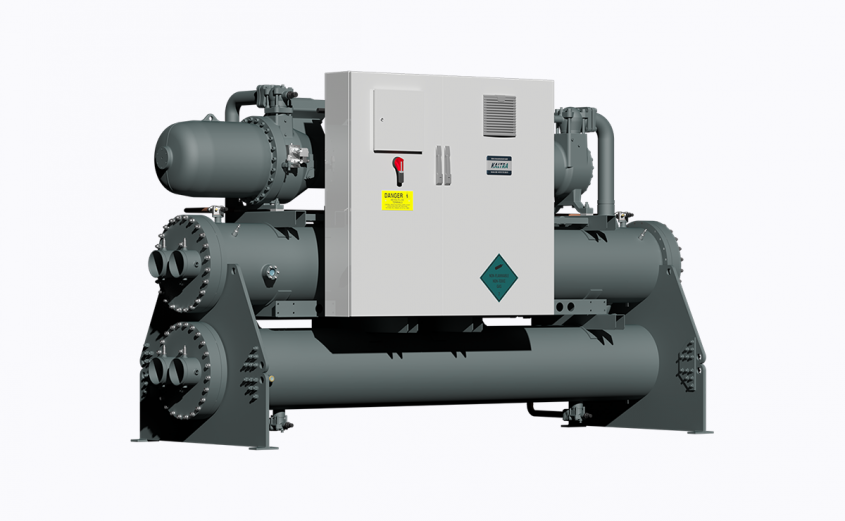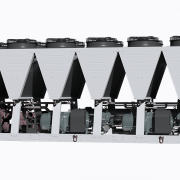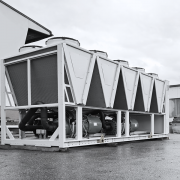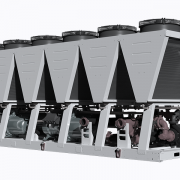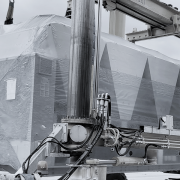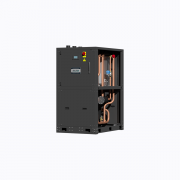Air-cooled vs. water-cooled chillers
Working Principle and Differences
A chiller is a heat transferring device that uses mechanical refrigeration to remove heat from a continuous flow of process liquid and transfers it to the environment, thus lowering the temperature of the process liquid. Chiller is connected to the process liquid system through an evaporator: a heat exchanger in which heat captured by the liquid flow is transferred to the flow of refrigerant fluid, and as the heat transfer takes place, the refrigerant evaporates, changing from a low-pressure liquid into vapor, while the temperature of the process liquid is reduced. Then, refrigerant gas flows to the compressor, which raises the pressure of the discharged gas to ensure its temperature is sufficiently high to release the heat in the condenser where the refrigerant changes back from vapor to a liquid state. The latent heat is rejected to the environment in either water or ambient air, depending on the type of condenser used in the system: air-cooled or water-cooled. Chillers with air-cooled condensers utilize air-to-refrigerant heat exchangers, while water-cooled chillers reject the heat via cooling tower or dry cooler.
An air-cooled condenser uses ambient air for cooling and condensing the refrigerant gas back to a liquid. It usually located inside the chiller or remotely, but ultimately it dissipates the heat to the atmosphere with airstream passing through the condenser coil.
Water-cooled condenser repetitively cycles the water between the cooling tower (or dry cooler) and the condenser. Hot refrigerant gas enters the condenser and transfers its heat into the water which is transported up to the cooling tower (or dry cooler) and rejected to the atmosphere.
Thereby, both air-cooled and water-cooled chillers depend on an airstream as a means of heat transfer.
Aspects Of The System Design
Though a great deal of variety for installation of both air-cooled and water-cooled chillers, some general installation rules do apply and can help to guide the chiller choice.
Installation Areas
Air-cooled chillers need fresh make-up air for condensers to extract heat from the refrigerant and almost invariably installed outdoors, while all water-cooled chillers intended for indoor installation in properly fitted mechanical rooms. Outdoor setup requires electrical control panels suitable for appropriate environmental conditions.
The units with water-cooled condensers are more compact compared to air-cooled chillers, but require large outdoor areas for installing cooling towers or dry coolers and space for circulation pumps and other system components. However, the capacity of air-cooled chillers is limited by transportation issues and typically not exceed 2MW per unit.
Environmental Conditions
As air-cooled chillers (as well as water-cooled systems equipped with dry coolers) rely on ambient air for cooling, their capacity and efficiency tied on the air temperature, although air humidity is irrelevant for this type of chillers. Contrastingly, water-cooled systems work great in high ambient conditions, but the efficiency of cooling towers lowers in humid environments.
The efficiency of air-cooled chillers in hot environments can be lifted significantly with evaporative pre-cooling systems where the ambient air sucked by condensers humidified and cooled down by passing through wet pads which are set in front of the heat rejection coils.
Water-cooled systems cannot be used in conjunction with open-loop cooling towers in cold climates due to the risks of freezing of water during operation in winter.
Water Consumption
Water-cooling systems equipped with cooling towers consume significant amounts of water due to evaporation and the need for periodic water removal and refresh, so air-cooled chillers should be the preferential choice for water conservation, especially in regions experiencing water scarcity. High water consumption is a core issue of water-cooled cooling systems and primary concern for the customers.
Noise Output
Air-cooled chillers produce higher noise levels (outdoor) via condenser fans. However, customers may select from various low-noise designs with reduced fan rotation speed and a number of other sound-proof options, resulting in sound pressure levels as low as 45-50dB(A) at 10m distance.
Efficiency and Economic Dimensions
Efficiency
At first glance, water-cooled chillers demonstrate higher energy efficiency due to operation on lower head pressure – in comparison to air-cooled units. Although at the general level, water-cooled systems include many energy-intensive components such as cooling towers and circulation pumps, while air-cooled chillers are stand-alone systems and include all necessary components. And when it comes to air-cooled versus water-cooled system selection, it is recommended to consider the initial and operating costs associated not only with the chillers but with the whole cooling system.
Modern air-cooled chillers, especially those equipped with inverter-driven centrifugal compressors (e.g., Turbocor oil-free compressors), display energy efficiency comparable with the efficiency of water-cooled units. While the initial price of such units is high, this is an investment that pays off.
In turn, cooling tower or dry cooler used in a water-cooled plant can actually be used as a free cooling system during cold weather, thus reducing the need in mechanical cooling and resulting in substantial energy savings.
In dry climates, the wet-bulb temperature can be significantly lower than the dry-bulb, and water-cooled chiller can operate with lower condensing temperatures, thus lowering the compressor power consumption. Therefore, a water-cooled chiller is inherently more efficient in dry climates compared to an air-cooled chiller.
Initial Costs
The difference in initial cost between air-cooled and water-cooled chillers often misleads the customers. Generally, water-cooled units have a lower initial price, while the overall price of water-cooled plants is usually higher, although it lowers with the increase of cooling plant capacity and running hours.
The installation cost for the water-cooled system is also higher compared to air-cooled chiller setup, which is easier and faster, and only require space, plumbing, and electricity service.
Operating Costs
Operating costs often is a paramount concern for cooling plant owners. Operating cost for air-cooled cooling plants mainly includes electricity cost and chiller maintenance cost, while the owner of a water-cooled plant pays for regular maintenance of a large set of equipment. When using a cooling tower in conjunction with a water-cooled chiller, additional costs also occur from the monitoring of water quality, chemical treatment of the water (to minimize the fouling as it is an open-loop system), and regular cleaning and top-up of the system with fresh water.
Environmental Safety
As most lower-GWP refrigerants are mildly flammable (in most cases belonging to the A2L flammability class), there are restrictions on where chillers can be installed. At present, air-cooled chillers intended for outdoor installation offer the advantage of environmental safety when running on low-GWP alternatives to HFC-based refrigerants.
Pros and Cons
Air-cooled chillers fit better for cooling plants of up to 2MW capacity, for cold or mild climates, and for regions where water resources are limited.
Pros:
- Lower initial cost for the cooling plant;
- Water-saving solution;
- Small installation area required;
- Easy and inexpensive maintenance.
Cons:
- Generally, lower energy efficiency;
- Capacity per unit is limited to about 2MW cooling.
Water-cooled chillers are perfectly suitable for large cooling plants, e.g., for district cooling.
Pros:
- High energy efficiency, especially when paired with open-loop cooling towers;
- Availability of large-capacity units.
Cons:
- High maintenance costs and high water consumption, particularly when running in conjunction with open-loop cooling towers;
- Larger installation area required for a cooling plant;
- Legionella risks.
Should Your Chillers Be Air-Cooled Or Water-Cooled?
The selection of an appropriate type of chiller depends on many factors according to the application: operating conditions, availability of water, the nature of the fluid to be cooled, available indoor and outdoor space, expected lifespan, corrosion resistance, legionella risks are among the aspects for selecting the suitable one.
In any given case, the pros and cons of water-cooled and air-cooled cooling systems have to be weighed diligently to get an optimal design.

